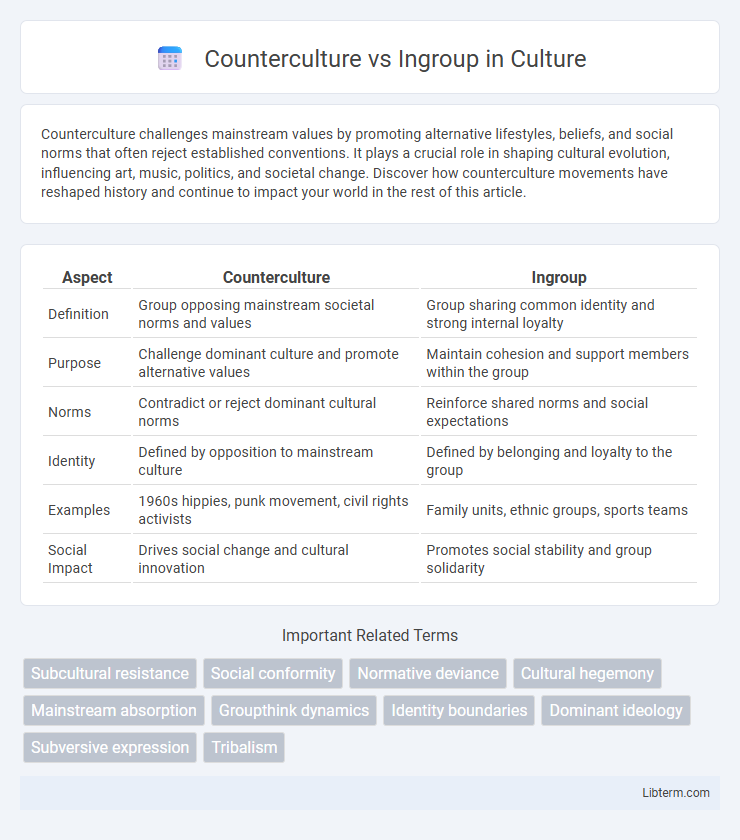Counterculture challenges mainstream values by promoting alternative lifestyles, beliefs, and social norms that often reject established conventions. It plays a crucial role in shaping cultural evolution, influencing art, music, politics, and societal change. Discover how counterculture movements have reshaped history and continue to impact your world in the rest of this article.
Table of Comparison
| Aspect | Counterculture | Ingroup |
|---|---|---|
| Definition | Group opposing mainstream societal norms and values | Group sharing common identity and strong internal loyalty |
| Purpose | Challenge dominant culture and promote alternative values | Maintain cohesion and support members within the group |
| Norms | Contradict or reject dominant cultural norms | Reinforce shared norms and social expectations |
| Identity | Defined by opposition to mainstream culture | Defined by belonging and loyalty to the group |
| Examples | 1960s hippies, punk movement, civil rights activists | Family units, ethnic groups, sports teams |
| Social Impact | Drives social change and cultural innovation | Promotes social stability and group solidarity |
Understanding Counterculture: Definition and Origins
Counterculture represents a social group whose values, norms, and behaviors significantly diverge from mainstream society, often arising as a reaction to perceived cultural or political dissatisfaction. Originating prominently during the 1960s, countercultures challenge established social norms by promoting alternative lifestyles, beliefs, and artistic expressions. This movement contrasts with the ingroup, which adheres to conventional cultural standards and maintains societal cohesion.
The Dynamics of Ingroup Identity
The dynamics of ingroup identity involve the formation of a shared sense of belonging and collective values that distinguish members from outgroups, reinforcing social cohesion and loyalty. Ingroup identity shapes perceptions, behaviors, and attitudes by emphasizing common norms, traditions, and symbols that strengthen group boundaries. Conflicts with countercultures often arise as these alternate groups challenge or redefine prevailing ingroup norms, leading to tensions and opportunities for social change.
Key Differences Between Counterculture and Ingroup
Counterculture actively opposes mainstream societal values and norms, promoting alternative lifestyles and beliefs that challenge the dominant culture, whereas an ingroup consists of individuals who share common identities, values, and experiences, reinforcing social cohesion within the dominant or a specific subgroup. Countercultures often face social resistance and seek structural change, while ingroups prioritize internal solidarity and mutual support without necessarily opposing wider societal norms. The distinction lies in counterculture's role as a transformative force contrasting with the ingroup's function as a stabilizing social unit.
Historical Examples of Countercultural Movements
The countercultural movements of the 1960s, including the Civil Rights Movement and the anti-Vietnam War protests, challenged mainstream societal norms and catalyzed significant social change. The Beat Generation in the 1950s exemplified a literary counterculture that rejected conventional values and paved the way for broader cultural shifts. These movements often faced resistance from dominant ingroups but ultimately reshaped cultural, political, and social landscapes by promoting values of equality, peace, and individual freedom.
Psychological Drivers Behind Ingroup Loyalty
Ingroup loyalty is driven by psychological needs for belonging, identity, and social validation, fostering strong emotional bonds within a group. This loyalty enhances self-esteem and reduces uncertainty by aligning individual beliefs with group norms, which contrasts with counterculture dynamics that challenge mainstream values and promote differentiation. Evolutionary factors such as coalition-building and collective survival further reinforce the human propensity toward ingroup cohesion and solidarity.
The Role of Social Norms in Shaping Group Behavior
Social norms function as unwritten rules that regulate group behavior, fostering cohesion within ingroups while often marginalizing counterculture groups. Ingroup members adhere to these shared norms to maintain identity and social order, whereas counterculture challenges them by promoting alternative values and behaviors. The dynamic tension between social conformity and dissent highlights the crucial role of norms in shaping collective behavior and group boundaries.
Counterculture as a Reaction Against Mainstream Ingroups
Counterculture arises as a deliberate reaction against mainstream ingroups, rejecting dominant social norms and values to create alternative lifestyles and identities. This resistance often manifests through distinctive behaviors, fashion, language, and beliefs that challenge prevailing cultural expectations. By opposing established ingroup norms, countercultures foster social change and promote diversity within broader society.
Effects of Counterculture on Societal Change
Counterculture movements challenge established norms by promoting alternative values and lifestyles, often sparking social and political reforms that reshape mainstream society. These movements influence cultural evolution by questioning dominant ideologies, leading to greater acceptance of diversity and innovation in areas like civil rights, gender equality, and environmentalism. The resulting societal change frequently manifests in new laws, shifts in public opinion, and the transformation of cultural institutions.
How Ingroups Respond to Countercultural Challenges
Ingroups often respond to countercultural challenges by reinforcing group norms and identity to maintain cohesion and boundary distinctions. Social identity theory explains that ingroups may perceive countercultural movements as threats, prompting defensive mechanisms such as stereotyping or exclusion to preserve status. This dynamic can escalate conflict but also highlights the ingroup's effort to sustain social order and collective values amidst cultural change.
Bridging the Gap: Fostering Dialogue Between Counterculture and Ingroups
Bridging the gap between counterculture and ingroups requires creating inclusive dialogue platforms that encourage mutual understanding and respect for diverse perspectives. Effective communication strategies emphasize active listening and empathy to dismantle stereotypes and reduce social polarization. Facilitating collaborative projects and shared goals helps integrate countercultural insights into mainstream group values, promoting social cohesion and innovation.
Counterculture Infographic

 libterm.com
libterm.com